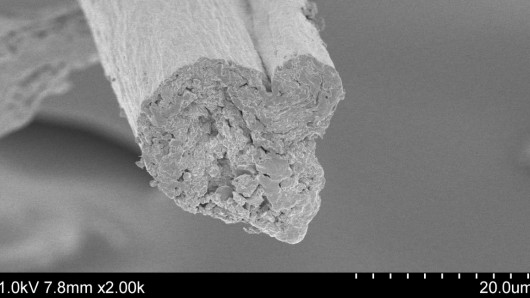
A team of researchers working at Stockholm's KTH Royal Institute of Technology claim to have developed a way to make cellulose fibers stronger than steel on a strength-to-weight basis. In what is touted as a world first, the team from the institute's Wallenberg Wood Science Center claim that the new fiber could be used as a biodegradable replacement for many filament materials made today from imperishable substances such as fiberglass, plastic, and metal. And all this from a substance that requires only water, wood cellulose, and common table salt to create it.
To produce the new material, the team took individual cellulose fibers and broke them down into their component strands or "fibrils." They then separated and re-bound these fibrils in a technique that results in filaments much stronger than the original fiber. While fibrils have been separated in other studies – and even used in strengthening composite materials – it is the recombining of these fibrils into a super-strong filament that has never been achieved before and is asserted to be a considerable breakthrough in this type of research. "We have taken out fibrils from natural cellulose fibers, then we have assembled fibrils again into very strong filament," said Fredrik Lundell, one of the researchers. "It is about 10 to 20 microns thick, much like a strand of hair." The team constructed a "flow-focusing" device (similar to a small-scale extruder) to reassemble the fibrils after they had been mixed with water and sodium chloride. Controlling their reassembly by carefully adjusting the pressure at which they were injected, the researchers were able to produce continuous, consistent strands of fiber from the fibrils. In this process, the way that they manipulate the angle at which the fibrils are brought together then determines the strength and stiffness of that fiber. For example, if the fibrils are aligned alongside each other, the material is rigid and inflexible, whereas if the fibrils are combined at angles to each other, the resulting material is more elastic and flexible. The useful upshot of this is that the fibrils can be used to produce not only strong, steel-like fibers, but more fibrous ones as well. As a result, wood cellulose could be made to replace cotton in textiles, or even be used as a substitute for the glass filaments used in fiberglass used to construct boats and cars. And, as the new material retains its original cellulose, it is still biodegradable just like the wood it came from. "Our research may lead to a new construction material that can be used anywhere where you have components based on glass fibers, and there are quite a few places," said Lundell. "The challenge we face now is to scale up the production process. We must be able to make long strands, many threads in parallel – and all this much faster than today. Nevertheless, we have demonstrated that we know how this should be done, so we've come a long way." A team of researchers working at Stockholm's KTH Royal Institute of Technology claim to have developed a way to make cellulose fibers stronger than steel on a strength-to-weight basis. In what is touted as a world first, the team from the institute's Wallenberg Wood Science Center claim that the new fiber could be used as a biodegradable replacement for many filament materials made today from imperishable substances such as fiberglass, plastic, and metal. And all this from a substance that requires only water, wood cellulose, and common table salt to create it.
A team of researchers working at Stockholm's KTH Royal Institute of Technology claim to have developed a way to make cellulose fibers stronger than steel on a strength-to-weight basis. In what is touted as a world first, the team from the institute's Wallenberg Wood Science Center claim that the new fiber could be used as a biodegradable replacement for many filament materials made today from imperishable substances such as fiberglass, plastic, and metal. And all this from a substance that requires only water, wood cellulose, and common table salt to create it.

 Previous page
Previous page Back to top
Back to top







